Utah’s varied landscapes, ranging from scorching deserts to cool mountain woodlands, are home to an impressive variety of lizard species. Each of the 23 species found here displays unique colors, patterns, and behaviors that reflect their adaptation to different habitats across the state.
Learning to identify these lizards can enhance your outdoor experiences and deepen your connection with Utah’s natural world. This guide provides clear descriptions, helpful identification tips, and photos to assist you in recognizing these fascinating reptiles during your hikes or explorations.
Common Lizards Found in Utah
Western Whiptail (Aspidoscelis tigris)

The Western Whiptail is a slender, fast-moving lizard known for its long tail that often exceeds its body length. It typically measures between 7 to 12 inches, including the tail, and features a striking pattern of black and yellow or white stripes running down its back. Its scales are smooth and shiny, giving it a sleek appearance. The coloration helps it blend into the arid and semi-arid landscapes it inhabits.
This species is easily identified by its rapid, whip-like tail movements and agile behavior. It is diurnal, actively hunting insects such as ants, beetles, and grasshoppers during the day. The Western Whiptail is non-venomous and relies on speed and camouflage to avoid predators. It is known for its curious and skittish nature, often darting quickly to cover when approached.
In Utah, the Western Whiptail is commonly found in deserts, rocky hillsides, and sandy washes primarily in the southern and western parts of the state. It prefers habitats with sparse vegetation like sagebrush and creosote bush. Its range overlaps with other whiptail species, but it tends to avoid densely forested areas, thriving in open, sunlit environments that support its insect prey.
Common Sagebrush Lizard (Sceloporus graciosus)
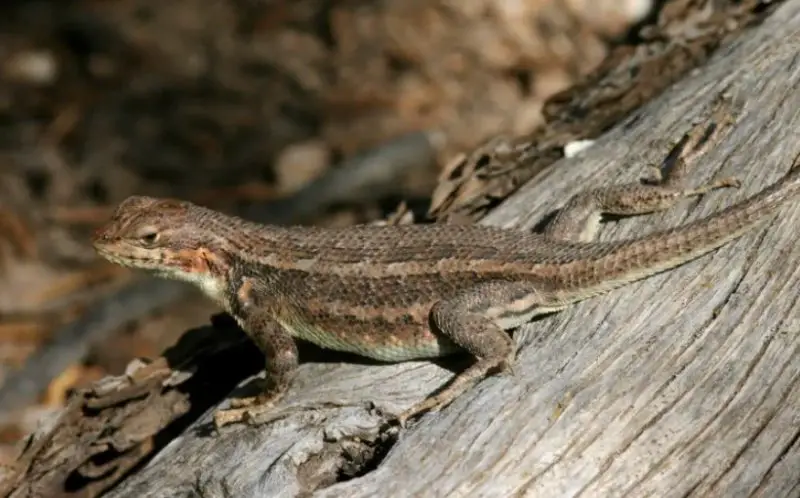
The Common Sagebrush Lizard is a medium-sized lizard, generally about 4 to 7 inches long, characterized by its rough, keeled scales and distinct patterning of dark blotches or stripes across its back. Its coloration varies from gray to brown, often matching the sagebrush environment it prefers, providing excellent camouflage. Males display bright blue patches on their throats and bellies, especially during the breeding season.
This species is identifiable by its flattened body and spiny scales, giving it a somewhat rugged texture. It is primarily insectivorous, feeding on ants, spiders, and other small arthropods. The Sagebrush Lizard is mostly terrestrial but can be seen basking on rocks or shrubs. It is active during the day and employs quick, jerky movements to catch prey and evade predators. It is non-venomous and harmless to humans.
In Utah, the Common Sagebrush Lizard is widely distributed in the high desert and mountainous regions dominated by sagebrush, piñon-juniper woodlands, and shrublands. It is highly adapted to cooler climates compared to desert lizards, often found at elevations between 4,000 and 9,000 feet. This species is an important part of the local ecosystem, helping control insect populations.
Western Fence Lizard (Sceloporus occidentalis)
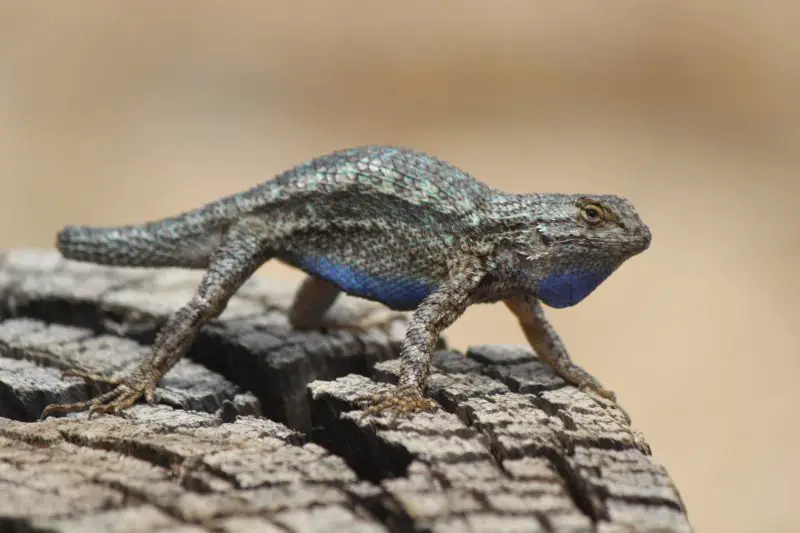
The Western Fence Lizard, also known as the “blue belly” lizard, is recognized for its distinct bright blue patches on the sides of its belly and throat. Adult individuals typically measure 5 to 8 inches in length. Its body color ranges from gray to brown with darker crossbands on the back, which help it blend into its rocky or woody surroundings. The rough, keeled scales provide a textured appearance.
Behaviorally, this lizard is territorial and often seen perched on fences, rocks, and logs, basking in the sun. It is diurnal and insectivorous, feeding on ants, flies, and other small insects. The Western Fence Lizard is known for its ability to run quickly and its characteristic push-up displays used to communicate with rivals or attract mates. It is non-venomous and poses no threat to humans.
Within Utah, the Western Fence Lizard is mostly found in the western and southwestern regions, occupying foothills, chaparral, and woodland edges. It thrives in habitats with plenty of sun exposure and is frequently spotted near human dwellings due to its adaptability. Its presence is often an indicator of a healthy insect population and balanced ecosystem.
Plateau Striped Whiptail (Aspidoscelis velox)
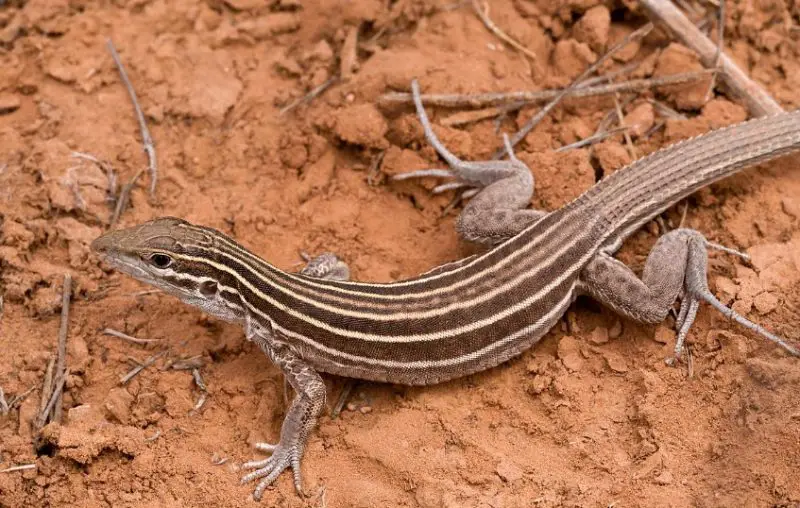
The Plateau Striped Whiptail is a slender, ground-dwelling lizard known for its long tail and fast, whip-like movements. It generally ranges from 6 to 10 inches in length. The lizard’s coloration features light brown to tan backgrounds with five distinct longitudinal white or yellow stripes running from head to tail. The scales are smooth and shiny, aiding in quick escapes from predators.
This species is active during the day and has a primarily insectivorous diet, feeding on ants, grasshoppers, and beetles. It is a non-venomous species that relies on its speed and agility to survive in its often harsh environment. The Plateau Striped Whiptail is known for its skittish behavior, quickly darting away when disturbed. Unlike some other whiptails, it can reproduce through parthenogenesis, where females lay viable eggs without fertilization by males.
In Utah, the Plateau Striped Whiptail is commonly found in the southern plateau regions, including parts of the Colorado Plateau. It favors rocky, arid habitats with sparse vegetation such as sagebrush and juniper. Its distribution is largely influenced by elevation and temperature, preferring warm, open areas where it can thermoregulate effectively.
Desert Spiny Lizard (Sceloporus magister)
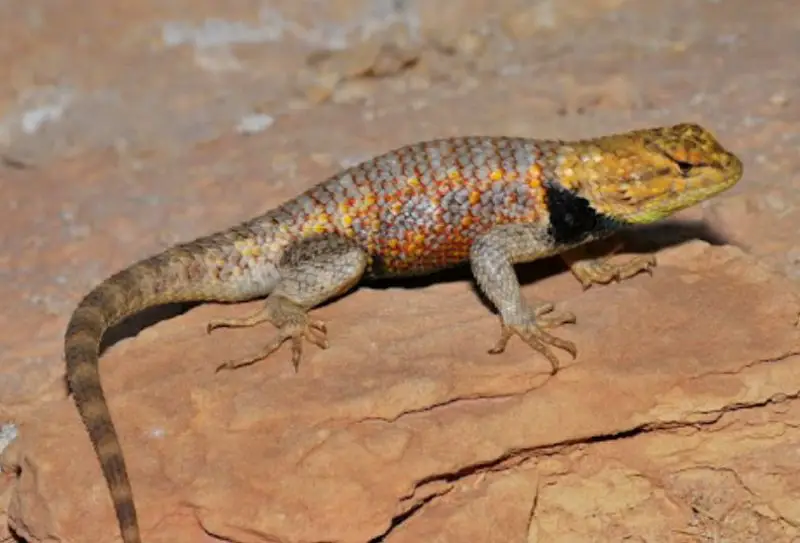
The Desert Spiny Lizard is one of the larger lizard species found in Utah, often measuring 6 to 10 inches from snout to tail tip. It has a robust body covered with prominent, keeled spiny scales that give it a rough texture. The coloration varies from gray to brown with darker blotches or bands, and males typically exhibit bright blue patches on their throats and sides, especially during mating season.
This species is highly territorial and frequently observed perched on rocks, cacti, or tree trunks, where it basks in the sun. It is primarily insectivorous but may also consume small vertebrates and plant matter. The Desert Spiny Lizard is non-venomous and uses its spiny scales and quick movements as defense mechanisms. When threatened, it may display aggressive behaviors such as head bobbing and tail whipping.
In Utah, the Desert Spiny Lizard inhabits the hot, arid regions of the southwestern part of the state, including desert basins and rocky canyons. It prefers habitats with ample sun exposure and vegetation such as mesquite and creosote bush. This lizard plays a vital role in controlling insect populations and serves as prey for larger predators in the desert ecosystem.
Great Basin Collared Lizard (Crotaphytus bicinctores)
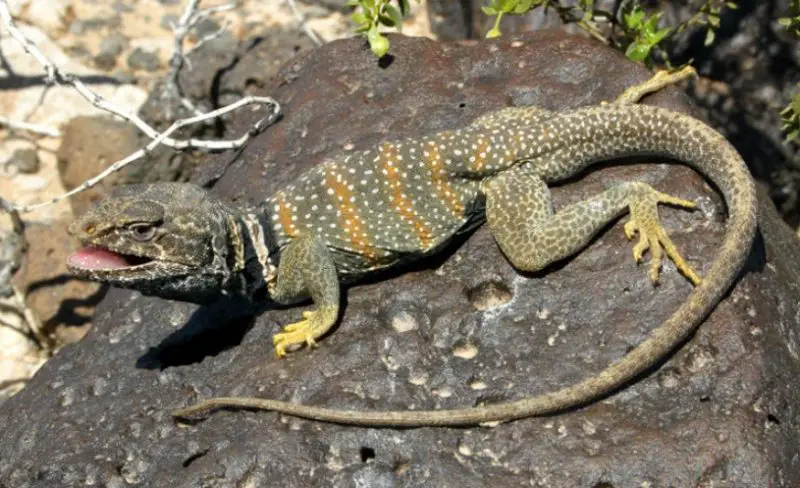
The Great Basin Collared Lizard is a robust and striking species, easily recognized by the two distinctive black bands or “collars” around its neck. Adults typically reach lengths of 6 to 8 inches, with males often showing brighter coloration that includes shades of yellow, green, and blue. Its body is stout with a large head and powerful jaws, adapted for crushing prey.
This species is known for its bold behavior and impressive speed, often seen sprinting across rocky terrain to catch prey or evade predators. It feeds primarily on insects, smaller lizards, and occasionally small rodents. The Great Basin Collared Lizard is non-venomous but uses its strength and quick reflexes as defense mechanisms. Its thick tail is used for balance and can sometimes be shed to distract predators.
In Utah, the Great Basin Collared Lizard inhabits the rocky desert slopes and foothills mostly in the southwestern regions. It favors arid environments with ample sun exposure, such as sagebrush flats and canyonlands. Its presence is an important indicator of ecosystem health, as it helps regulate insect and small reptile populations.
Long-nosed Leopard Lizard (Gambelia wislizenii)
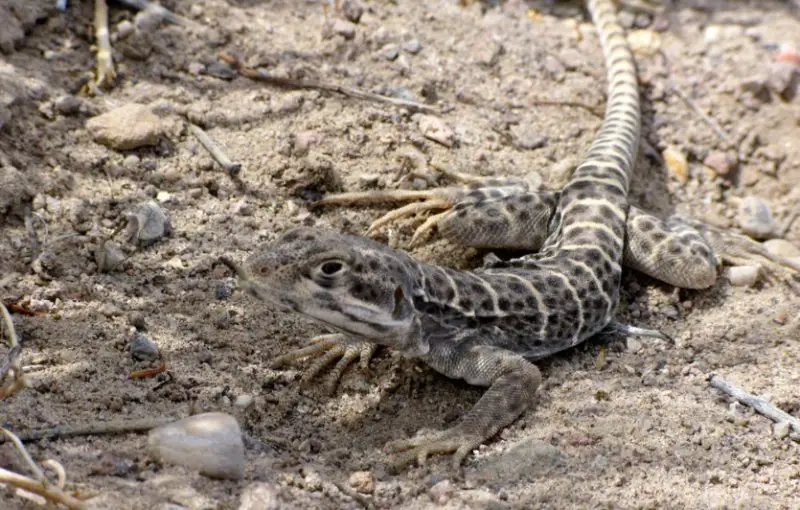
The Long-nosed Leopard Lizard is a medium-sized lizard notable for its elongated snout and striking leopard-like spots across its body. Adults measure about 6 to 9 inches long. Its coloration includes a sandy or tan background with bold black or dark brown spots, providing effective camouflage in its desert surroundings.
This species is an active predator, feeding mainly on insects, smaller lizards, and occasionally small mammals. It is highly territorial and often seen basking on rocks or patrolling open areas. The Long-nosed Leopard Lizard is non-venomous but can deliver a strong bite if threatened. It relies on speed and stealth to capture prey and evade threats.
In Utah, it inhabits arid and semi-arid regions, especially in the southern deserts and canyonlands. It prefers open, rocky habitats with sparse vegetation, such as creosote bush and sagebrush areas. Its distribution overlaps with other desert lizard species but can often be distinguished by its distinctive long nose and spotted pattern.
Mojave Fringe-toed Lizard (Uma scoparia)
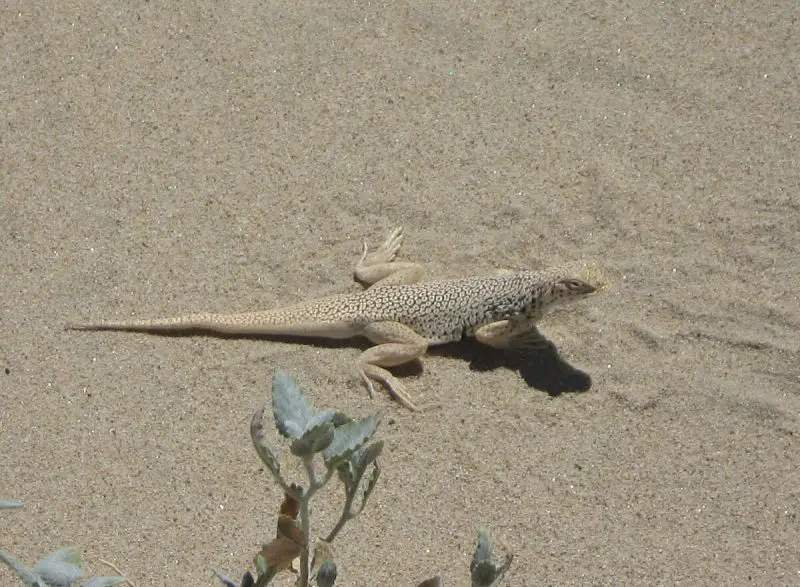
The Mojave Fringe-toed Lizard is specially adapted to life in sandy desert environments. Typically measuring 3 to 5 inches long, it is characterized by its fringed scales along the sides of its toes, which aid in running and digging on loose sand. Its coloration is usually pale tan or cream with subtle blotches, perfectly camouflaging it against desert dunes.
This lizard is a swift and agile forager, feeding primarily on ants and other small insects found in sandy soils. It spends much of its time burrowing or hiding beneath sand to avoid the extreme heat of its habitat. The Mojave Fringe-toed Lizard is non-venomous and uses its ability to “swim” through sand to escape predators.
In Utah, this species is restricted to the Mojave Desert region in the southwestern corner of the state. It inhabits sandy dune fields and desert flats with loose, fine sand, where its fringed toes give it a competitive advantage. Conservation efforts monitor its habitat closely due to its specialized niche.
Desert Horned Lizard (Phrynosoma platyrhinos)
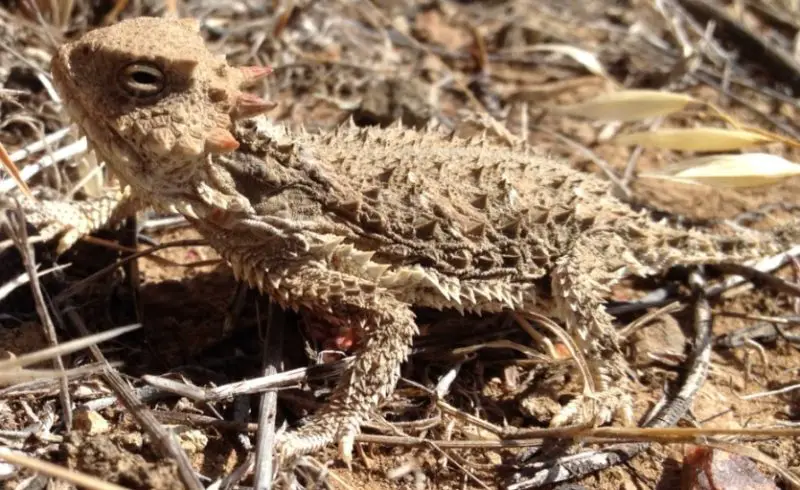
The Desert Horned Lizard is a stout, flat-bodied reptile known for the distinctive crown of spines around its head, which serve as protection from predators. Adults range from 3 to 5 inches in length. Its coloration is usually sandy to reddish-brown, matching the desert soils it inhabits, and helps it blend seamlessly into its environment.
This species feeds primarily on ants but will also consume other insects. It uses a sit-and-wait hunting strategy, relying on its camouflage to avoid detection. The Desert Horned Lizard is non-venomous but possesses an unusual defense mechanism: it can squirt blood from its eyes to confuse predators. Its slow movements are compensated by this unique adaptation.
In Utah, the Desert Horned Lizard is commonly found in arid desert habitats, especially in sandy and rocky areas of the southwestern part of the state. It prefers open terrain with sparse vegetation like sagebrush and creosote bush. This lizard plays a key ecological role in controlling ant populations.
Greater Short-horned Lizard (Phrynosoma hernandesi)
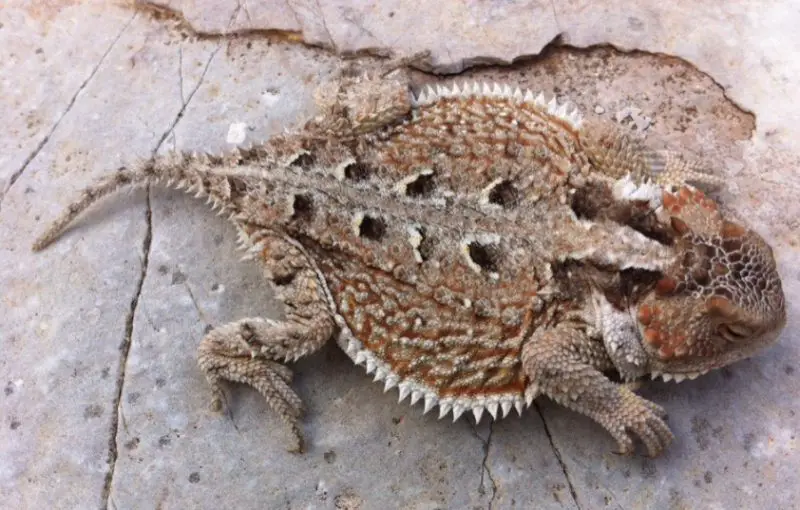
The Greater Short-horned Lizard is a robust, rounded species that can grow up to 5 inches long. It is distinguished by its short, blunt horns and spiny body, which provide excellent camouflage among rocks and leaf litter. Its coloration varies from gray to brown, often with mottled patterns that mimic its environment.
This lizard primarily feeds on ants but will occasionally eat other insects. It is known for its defensive behaviors, including puffing up its body to appear larger and flattening itself against the ground. Like other horned lizards, it can squirt blood from its eyes as a predator deterrent. It is non-venomous and generally slow-moving but well-adapted for survival in harsh conditions.
In Utah, the Greater Short-horned Lizard inhabits higher elevation areas such as mountainous foothills and sagebrush steppe across central and northern parts of the state. It favors cooler climates compared to other horned lizards and occupies rocky, semi-arid environments where it can blend in perfectly.
Northern Alligator Lizard (Elgaria coerulea)
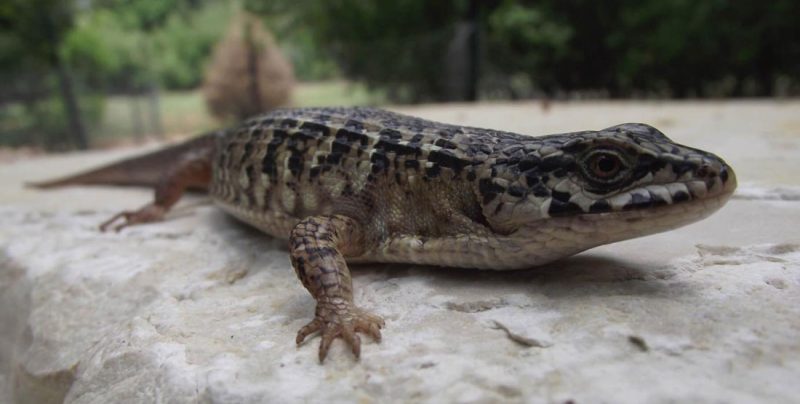
The Northern Alligator Lizard is a medium-sized, slender reptile typically measuring 7 to 11 inches in length. It has rough, overlapping scales and a long tail often twice the length of its body. The coloration varies but usually includes a pattern of dark brown or black blotches on a gray or brown background, allowing it to blend well into forest floor litter.
This species is primarily terrestrial and secretive, often hiding under logs, rocks, or leaf litter during the day. It feeds on a diet of insects, spiders, and small amphibians. The Northern Alligator Lizard is non-venomous and relies on its agility and camouflage to avoid predators. It can deliver a mild bite if threatened and may exhibit tail autotomy (dropping its tail) as a defensive mechanism.
In Utah, the Northern Alligator Lizard is found mostly in moist, forested areas and mountainous regions, especially in the northern and central parts of the state. It prefers habitats with abundant ground cover, such as coniferous forests and riparian zones, where it can find shelter and prey.
Great Basin Skink (Plestiodon obsoletus)
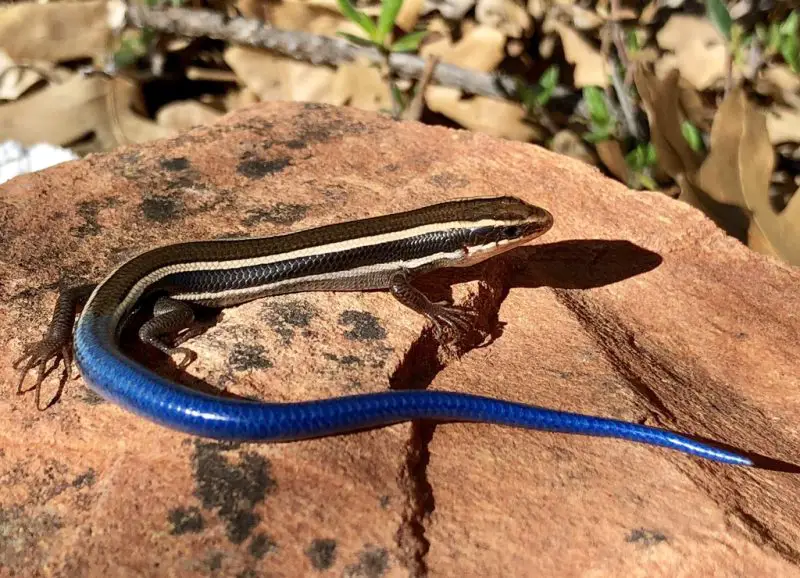
The Great Basin Skink is a relatively large skink species, growing up to 10 inches long including its tail. It has smooth, shiny scales that range in color from light brown to gray, often with faint stripes along the body. Its robust body and short legs give it a streamlined appearance adapted for quick movement through leaf litter and loose soil.
This skink is diurnal and insectivorous, feeding on beetles, ants, and other small invertebrates. It is known for its secretive behavior, often burrowing or hiding under rocks and logs to avoid predators. Like other skinks, it can shed its tail to escape capture and regenerate it later. The Great Basin Skink is non-venomous and uses speed and camouflage for protection.
Within Utah, the Great Basin Skink inhabits rocky and semi-arid areas, often in sagebrush steppe and desert foothills. It is most common in the western and southern parts of the state. Its preference for loose, sandy soils and moderate vegetation cover helps it survive in harsh environments.
Western Skink (Plestiodon skiltonianus)

The Western Skink is a small to medium-sized lizard, measuring about 4 to 7 inches in total length. It is easily recognized by its smooth, shiny scales and the bright blue tail of juveniles, which fades in adults. The body coloration is generally brown to olive with five light stripes running longitudinally down its back.
This species is active during the day and feeds primarily on small insects and arthropods. It is a ground-dwelling skink that prefers moist habitats and can often be found under rocks, logs, or debris. The Western Skink is non-venomous and uses its speed and agility to escape predators. Its tail, which is bright blue in young individuals, serves as a distraction to predators.
In Utah, the Western Skink is found in a variety of habitats ranging from grasslands to open woodlands, mostly in the northern and central regions. It favors areas with loose soil and ample cover, often near streams or moist microhabitats that support its insect prey.
Many-lined Skink (Plestiodon multivirgatus)
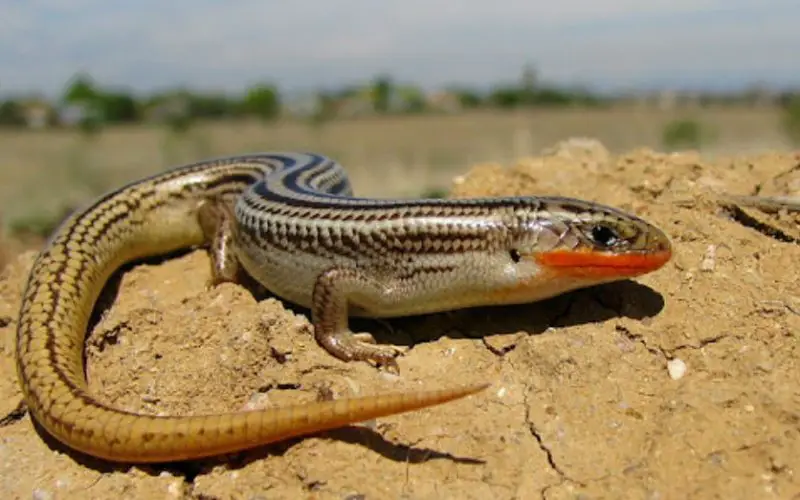
The Many-lined Skink is a small, slender lizard measuring about 4 to 6 inches long. It is named for the numerous thin, light-colored stripes running lengthwise along its dark brown to black body. The stripes provide excellent camouflage in the grassy and rocky habitats it frequents.
This skink is insectivorous, feeding on ants, spiders, and small insects. It is primarily ground-dwelling but can climb low vegetation when necessary. The Many-lined Skink is non-venomous and known for its quick movements and ability to drop its tail to evade predators. Its behavior includes basking on warm rocks and seeking shelter under debris.
In Utah, the Many-lined Skink occupies rocky hillsides, grasslands, and shrub-steppe habitats mainly in the eastern and southeastern parts of the state. It prefers areas with loose soil and scattered rocks where it can hide and hunt effectively.
Prairie Lizard (Sceloporus consobrinus)
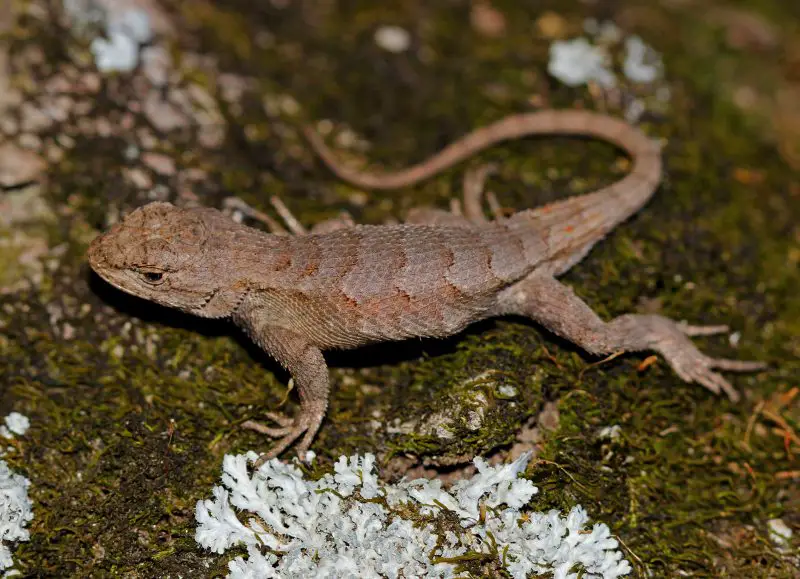
The Prairie Lizard is a medium-sized spiny lizard, measuring 4 to 7 inches in total length. It has rough, keeled scales and a coloration that ranges from tan to brown with darker crossbands or blotches. Males often show bright blue patches on their bellies and throats, especially during breeding season, which aids in identification.
This species is diurnal and terrestrial, frequently seen basking on rocks or fence posts in open prairie and grassland habitats. It feeds on a variety of insects and arthropods, using quick bursts of speed to catch prey. The Prairie Lizard is non-venomous and employs push-up displays and body flattening as territorial and defensive behaviors.
In Utah, the Prairie Lizard is found primarily in the eastern plains and grasslands, where it thrives in open sunny areas with scattered rocks and low vegetation. It plays an important role in controlling insect populations in prairie ecosystems.
Eastern Fence Lizard (Sceloporus undulatus)
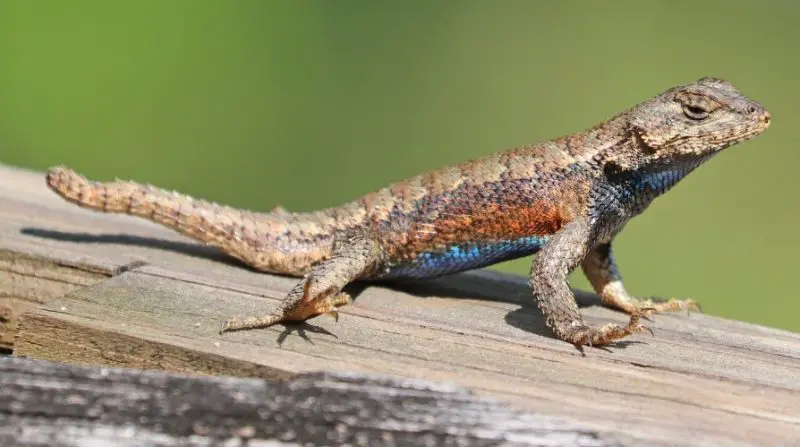
The Eastern Fence Lizard is a medium-sized spiny lizard that typically measures 4 to 7 inches in total length. It has rough, keeled scales and a coloration that ranges from gray to brown with darker crossbands or blotches along its back. Males often display bright blue patches on their throats and bellies, especially during the breeding season, which distinguishes them from females.
This species is primarily terrestrial and diurnal, often seen basking on rocks, logs, or fences in open woodlands and edge habitats. It feeds mainly on insects and other small arthropods. The Eastern Fence Lizard is non-venomous and known for its quick movements and territorial displays such as head bobbing and push-ups to communicate with rivals or attract mates.
In Utah, the Eastern Fence Lizard is mostly found in the southeastern part of the state where its preferred habitats include rocky outcrops, woodlands, and shrublands. It thrives in sunny environments with ample basking spots and plays an important role in controlling insect populations.
Common Side-blotched Lizard (Uta stansburiana)
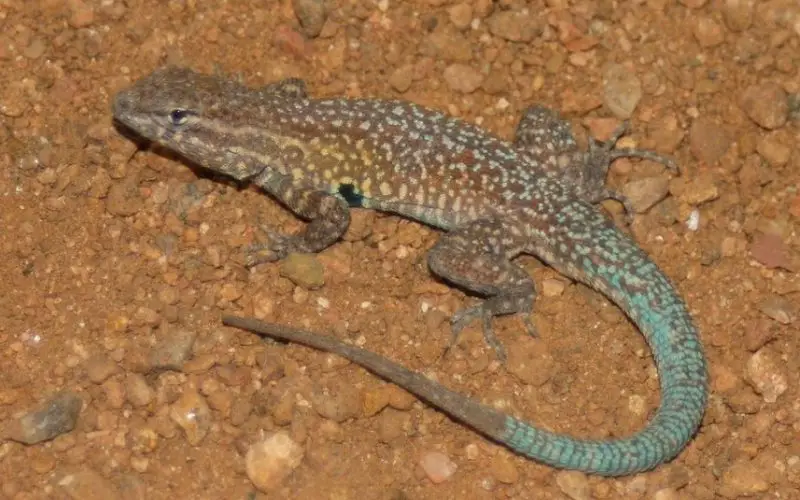
The Common Side-blotched Lizard is a small lizard usually measuring 2 to 3 inches in length. It is named for the distinctive dark blotch located just behind each front leg. Its coloration varies widely, ranging from pale tan to reddish brown with scattered spots, enabling it to blend well into desert and rocky environments.
This species is highly adaptable and active during the day, feeding mainly on ants, beetles, and other small insects. It is non-venomous and uses quick bursts of speed and camouflage to avoid predators. The Side-blotched Lizard exhibits complex mating behaviors, including multiple male morphs with different reproductive strategies.
In Utah, the Common Side-blotched Lizard is widespread throughout the southern and western deserts and foothills. It favors open, sandy or rocky habitats with sparse vegetation, such as sagebrush and creosote bush communities. Its ability to thrive in harsh desert conditions makes it one of the most common lizards in the state.
Western Side-blotched Lizard (Uta stansburiana elegans)
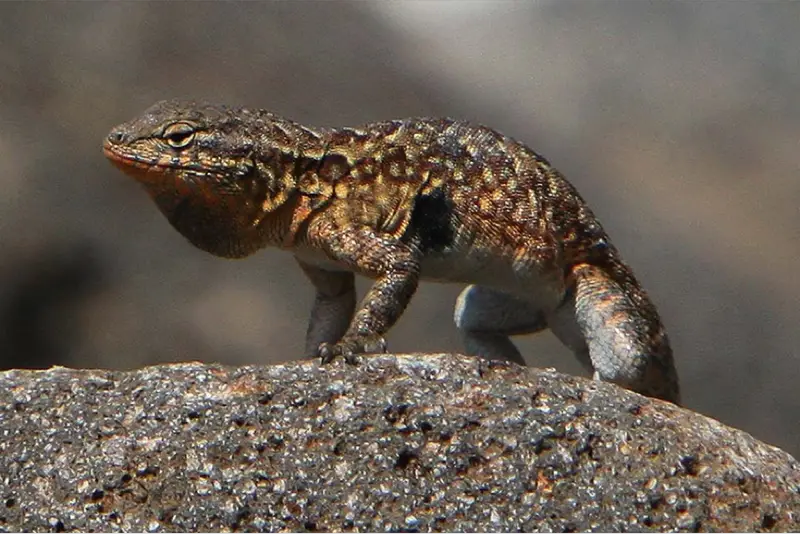
The Western Side-blotched Lizard is a subspecies of the Common Side-blotched Lizard and shares many characteristics with it. It generally measures 2 to 3 inches long and displays the signature side blotch behind the forelimbs. Its coloration tends toward a more orange or reddish hue, especially in males during the breeding season.
This lizard is diurnal and insectivorous, feeding primarily on ants, spiders, and small insects. Like its close relatives, it is non-venomous and relies on speed and camouflage to escape threats. The Western Side-blotched Lizard is known for its territorial behavior and complex mating dynamics among males.
In Utah, this subspecies is found primarily in the western desert regions, including the Great Basin. It inhabits sandy flats, rocky slopes, and scrubland areas where it can easily find prey and shelter. Its adaptability to varying desert environments contributes to its wide distribution.
Southern Alligator Lizard (Elgaria multicarinata)

The Southern Alligator Lizard is a moderately sized lizard, typically 6 to 11 inches long, with a slender body covered in rough, keeled scales. Its coloration ranges from brown to gray with dark bands or spots along its back and tail. It has a distinctive long tail and a somewhat flattened head, resembling that of an alligator.
This species is primarily terrestrial and secretive, often found hiding under logs, rocks, or leaf litter. It feeds on insects, spiders, and small vertebrates such as young lizards or amphibians. The Southern Alligator Lizard is non-venomous and uses quick movements and tail autotomy as defense mechanisms.
In Utah, this species is uncommon and mostly restricted to the southwestern corner near moist riparian habitats or higher elevations where humidity is greater. It prefers forested or shrub-covered areas that provide ample cover and prey availability.
Zebra-tailed Lizard (Callisaurus draconoides)
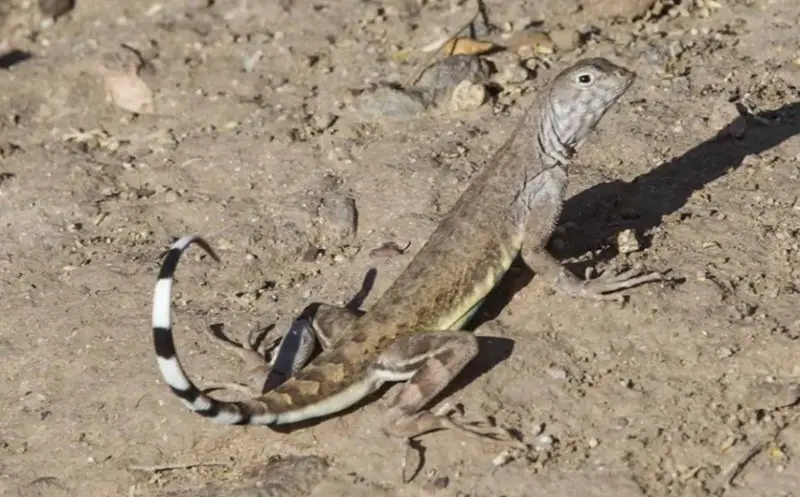
The Zebra-tailed Lizard is a medium-sized, slender lizard typically measuring 5 to 7 inches in length. It is named for the distinctive black and white striped pattern on the underside of its tail, which it often displays by curling its tail over its back when running. Its dorsal coloration is generally sandy or light brown with darker spots, providing excellent camouflage in desert environments.
This species is highly active and fast-moving, spending much of its time in open sandy or rocky desert habitats. It feeds primarily on insects and other small arthropods. The Zebra-tailed Lizard is non-venomous and uses its speed and tail display to confuse predators. When threatened, it runs in short bursts with its tail curled, flashing the striped pattern as a distraction.
In Utah, the Zebra-tailed Lizard is found mainly in the hot, arid deserts of the southwestern region. It prefers sandy flats, washes, and rocky areas with sparse vegetation such as creosote bush. Its distinctive tail pattern and rapid movements make it one of the more noticeable lizards in its habitat.
Tiger Whiptail (Aspidoscelis tigris)
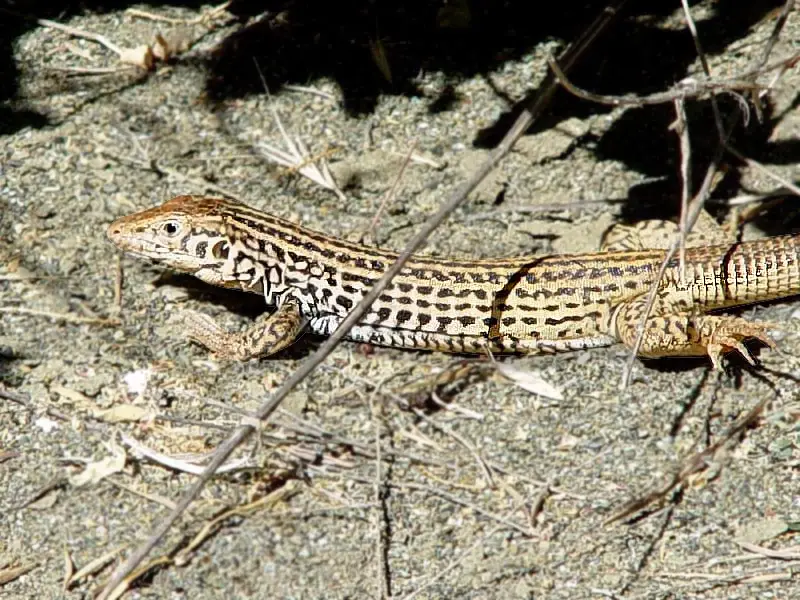
The Tiger Whiptail is often considered synonymous with the Western Whiptail but can be distinguished by subtle differences in coloration and pattern. It is a slender, agile lizard measuring 7 to 12 inches long, characterized by tiger-like dark stripes or blotches over a yellow or tan background. Its smooth, shiny scales aid in rapid movement across desert and scrub habitats.
This species is diurnal and insectivorous, hunting ants, beetles, and grasshoppers during the day. It is non-venomous and relies on speed and camouflage to avoid predators. The Tiger Whiptail is known for its skittish behavior and rapid, whip-like tail movements that give the species its common name.
In Utah, the Tiger Whiptail inhabits arid and semi-arid environments, especially in the southern and western desert regions. It favors open, sunny areas with sparse vegetation such as sagebrush and creosote, overlapping with the range of other whiptail species but often distinguishable by its pattern.
FAQs about Lizards in Utah
What are the most common lizard species found in Utah?
Some of the most common lizards in Utah include the Western Whiptail, Common Sagebrush Lizard, Western Fence Lizard, Plateau Striped Whiptail, and Desert Spiny Lizard. Each species occupies different habitats across the state, from deserts to mountainous regions.
Are any lizards in Utah venomous?
No, none of the lizard species native to Utah are venomous. They rely on speed, camouflage, and sometimes defensive behaviors such as tail dropping or displaying spines to evade predators.
What habitats do Utah lizards prefer?
Lizards in Utah inhabit a wide range of environments, including deserts, sagebrush flats, rocky hillsides, woodlands, and mountainous regions. Each species has specific preferences, often related to temperature, vegetation, and prey availability.
How can I identify a Western Whiptail?
The Western Whiptail is slender with a long tail and distinct black and yellow or white stripes running down its back. It is known for its rapid movements and whip-like tail flicks.
Do lizards in Utah pose any threat to humans?
No, Utah’s lizards are harmless to humans. They are generally shy and will avoid contact. They do not bite unless provoked, and even then, their bite is not dangerous.
How do lizards in Utah survive extreme temperatures?
Many lizards regulate their body temperature through behavioral adaptations such as basking in the sun during cooler periods and seeking shade or burrowing to avoid overheating. They are most active during moderate temperatures.
What do Utah lizards eat?
Most lizards in Utah are insectivores, feeding on ants, beetles, grasshoppers, spiders, and other small arthropods. Some may occasionally eat small vertebrates or plant matter.
Can lizards in Utah regenerate lost tails?
Yes, many lizard species, including whiptails and skinks, can drop their tails as a defense mechanism and later regenerate them over time.
When is the best time to see lizards in Utah?
Lizards are generally most active during spring and summer when temperatures are warm but not extreme. Early mornings and late afternoons are ideal times for observing them basking or hunting.


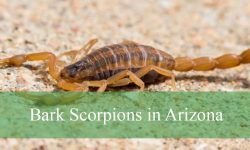
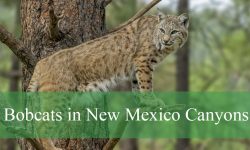
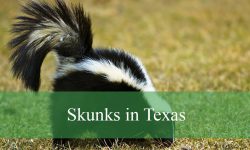
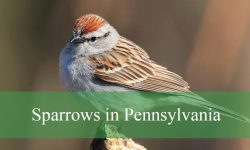

The Gila Monster is a species of venomous lizard native to the Southwestern United States.
The Gila monster is found in the Southwestern United States and Mexico, across a range including Sonora, Arizona, and parts of California, Nevada, Utah, and New Mexico.
Thanks for your info